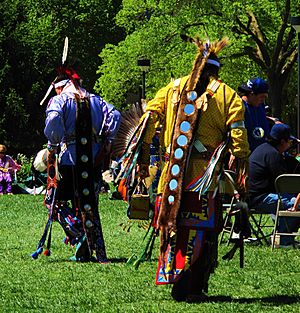Straight dance facts for kids
The Straight Dance is a special type of Native American dance. You often see it at pow wows. It's also called the Southern Straight Dance or Southern Traditional. This dance tells a story. It's about groups of hunters or warriors looking for their opponents.
Where Did the Straight Dance Come From?
The Straight Dance started with Native American tribes. These tribes lived in the Southern Plains region. This area is now mostly in Oklahoma. Many people believe the Ponca tribe created this dance. They had a special group called the Hethuska. This group was known for its warrior traditions.
Other tribes like the Pawnee, Omaha, Osage, and Kiowa also have similar dance traditions. In the 1900s, many warrior groups changed or ended. The Straight Dance then grew from older war dances. It became a way to keep tribal history and traditions alive.
What Does the Straight Dance Look Like?
The Straight Dance is seen as very respectful and formal. It is different from other pow wow dances. Dancers use a special "toe-heel" step. They tap their toe on the first drum beat. Then they place their whole foot down on the second beat.
The dance shows a hunting or warrior party. Because of this, dancers never move backward. Moving backward would mean retreating from an opponent. Instead, they always dance forward in a circle. They move around the circle in a clockwise direction. This dance is from the Southern Plains. So, it is danced to the beat of a Southern Drum.
What Do Straight Dancers Wear?
Straight Dancers wear special clothes called regalia. This includes a ribbon shirt and decorated leggings. They also wear aprons and a headdress. The headdress is often a roach or a turban.
Dancers add many accessories. These include woven garters and beaded belts. They might also wear vests or bandoliers. Shiny German silver armbands are common. Scarfs are also part of the outfit.
A key part of the Straight Dance regalia is the otter dragger. This is also called an otterhide. It hangs from the dancer's back. It drags along the ground as they dance. The otter dragger is often decorated. It can have medals, beadwork, or feathers. Straight dancers usually carry something in their hand. This might be a fan, a mirror board, or a tail stick.



